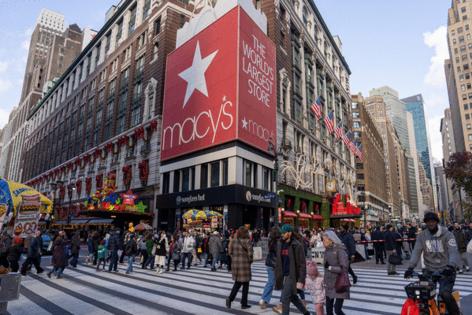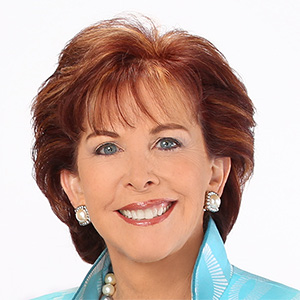Anxious retailers look to deals, doorbusters to revive sales
Published in Business News
The lure of $10 gift cards wasn’t enough to draw big early-bird Black Friday crowds at the Macy’s Inc. flagship New York City location in Herald Square when it opened at 6 a.m.
Andre Langer, 26, and Nicole Galler, 25, were visiting from Germany and arrived at Macy’s when it opened, hoping to see people storm through the entrance. There were fewer shoppers than they expected, though, and they weren’t impressed with the deals. “They’re not that good,” Langer said.
Macy’s and other retailers that cater to middle-income consumers went into the holiday shopping season hoping that exclusive products and special deals could help revive demand in an otherwise humdrum year.
Best Buy Co. brought back doorbuster events with big, limited-time promotions on popular items following a five-year hiatus. Target Corp. was counting on exclusive items like Taylor Swift’s "The Eras Tour Book" to drive demand. Meanwhile, Kohl’s Corp. discounted more electronics and appliances from brands like Dyson, Dr. Dre and Keurig.
Their efforts speak to the high stakes that many retailers are facing after a year of sluggish sales. Some are kicking off the biggest shopping holiday with new chief executives, raising the stakes even higher to generate stronger sales. To add to challenges, the shopping season is five days shorter this year than it was in 2023 due to a late Thanksgiving.
For the most part, their efforts didn’t appear to be enough to draw early crowds. A Best Buy in Mount Vernon, New York, was nearly empty a little before 8 a.m., with traffic much slower than expected, according to a security guard stationed there.
Soft expectations
U.S. retailers garner about 20% of their annual sales during the holiday season, and early projections have pointed to this year being softer than those past.
Online and in-person U.S. holiday sales are expected to rise between 2.5% and 3.5% this year, according to the National Retail Federation, an industry group. That’s behind last year’s growth of 3.9%. Those figures reflect sales for November and December and aren’t adjusted for inflation.
Some of the slowdown may stem from early gift buying that’s not captured in holiday sales data for the last two months of the year. Various sales events in October — such as Amazon.com Inc.’s Prime Day — likely pulled forward shopping demand, according to Coresight Research, affecting traditional holiday sales days like Black Friday. About 52% of consumers began holiday shopping before November, higher than last year.
E-commerce sales heading into Black Friday were strong, as shoppers continue to shift their spending from stores to websites and mobile apps. U.S. consumers spent a record $6.1 billion online on Thanksgiving, up 8.8% from the same period a year earlier, according to Adobe Analytics data. Growth outpaced last year, which was up 5.5% year over year.
At the King of Prussia mall in Pennsylvania on Friday morning, business owner Carla Schiavo said she hasn’t seen many good deals. “I got better deals the last two weeks online,” Schiavo, 49, said.
Salesforce Inc. expects this year’s holiday shopping season to be the most promotional since 2018. On Thanksgiving Day, the average discount rate in the U.S. was 28%. Sales typically get a bit better throughout the weekend and Cyber Monday.
Turnaround hopes
At the JCPenney at Fox Run Mall in Newington, New Hampshire, Rick Palardy, a 47-year-old electrician from southern Maine, was looking for everyday essentials to stretch his family’s budget.
“I’m one of those people, just trying to save money,” Palardy said. He bought bedding, warm clothes, and rolling luggage in various colors and sizes.
While all retailers look to the holidays for a boost, those that cater to middle-income shoppers are feeling particularly pinched by a slowdown in discretionary spending.
Under Macy’s Chief Executive Officer Tony Spring, who took over in February, the largest department store in the U.S. by revenue and number of stores is trying to draw more shoppers. The company is offering new items and displaying them in stores in a more engaging way, while still trying to keep investors satisfied by not dinging profitability too much.
Macy’s discounts this year were roughly in line with last year, including 40% to 50% off some boots and shoes and 50% off select handbags and wallets, but it’s betting newer products from different brands will attract shoppers. Traffic at the Herald Square Macy’s picked up as the day continued.
Target, which cut its annual forecast last week following years of disappointing sales, saw an early rush in some stores of Taylor Swift fans who showed up to buy "The Eras Tour Book" and limited-edition CDs and vinyls, which went on sale exclusively in the retailer’s stores on Friday.
At 8:45 a.m., Sasha Drozdetski of Ardsley, New York, was already on her second Target trip of the day, wearing a full Swift-themed sweat suit.
Drozdetski, 34, had first arrived at the White Plains, New York, store at 5:30 a.m., she said. By 5:58 a.m. she and about 50 other Swifties were let in to buy the items. In line, she said, “we were trading friendship bracelets.”
That early rush had done a decent job of clearing out inventory, but the initial purchase limit of two items per person was raised to four items a bit before 8:30 a.m., said Alexander, a service-engagement employee at the location, who declined to give his last name.
Other parts of the store looked largely untouched in the early morning.
Heading into the holiday season, Target cited slowing demand for discretionary products, such as apparel and home decorations. It’s offering daily holiday deals this month and next and selling 50% more new items this year.
In-person slowdown
The pace of shoppers visiting stores in person was expected to slow somewhat this Black Friday versus last year, according to Grant Gustafson, head of retail consulting and analytics at Sensormatic Solutions, a retail technology provider. Shoppers are tired of price increases since the pandemic and are prioritizing spending on essentials, he said.
Last year, in-person store visits rose 5.2% on Black Friday versus the prior year. “It may be a stretch to expect the same level of year-over-year growth we saw last year,” Gustafson said.
Overall foot traffic is likely to be flat to slightly down during November and December compared with 2023, Gustafson says.
At a Macy’s in Bethesda, Maryland, workers were still giving out $10 gift cards two-and-a-half hours after opening. The promotion was supposed to just be for the first 100 customers, but an employee said they decided to hand out more.
———
(With assistance from Lily Meier, Deena Shanker, Julia Fanzeres, Michelle Fay Cortez and Allyson Versprille.)
©2024 Bloomberg L.P. Visit bloomberg.com. Distributed by Tribune Content Agency, LLC.












Comments